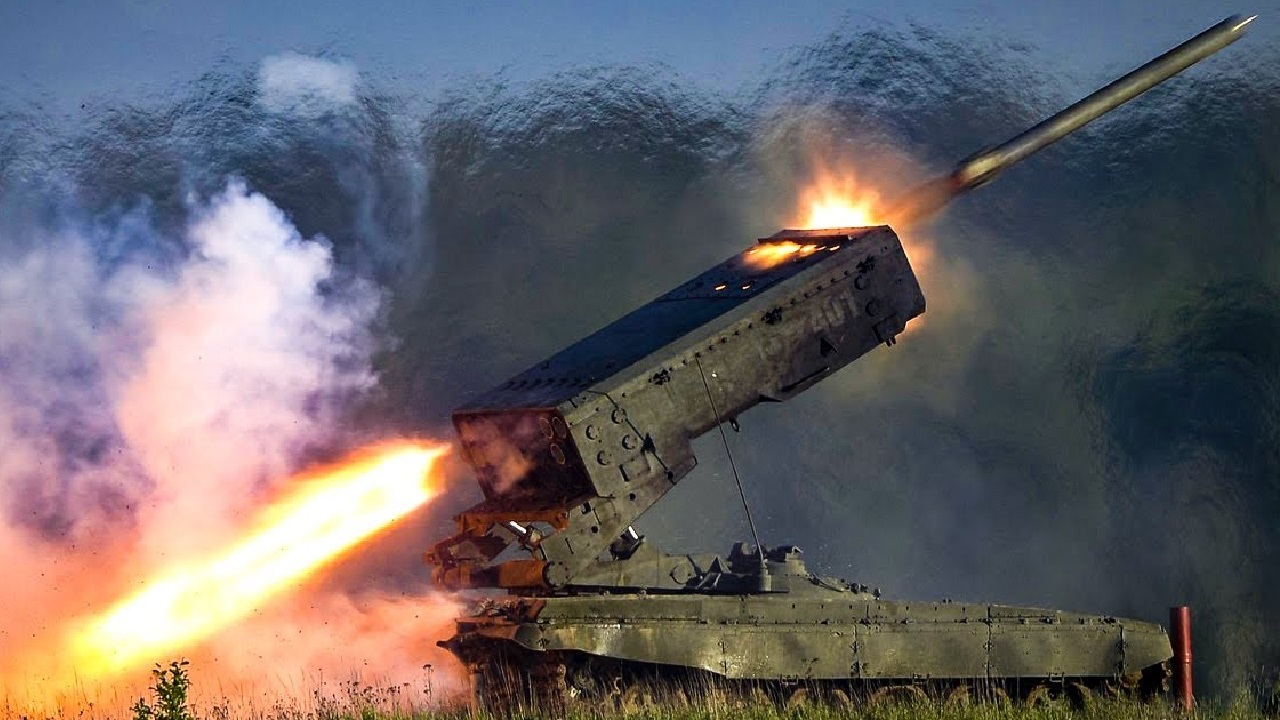TOS-1A: A Primer – Last month, video footage depicting a Russian attack in the Yasynuvata Raoin district in central Ukraine circulated on social media. The small village had already seen much of its infrastructure destroyed in previous battles over the last fourteen-plus month invasion of Ukraine.
In the most recent assault, Russian forces reportedly used thermobaric weapons to carry out its attack. In the footage, a Russian T-72 main battle tank (MBT) is seen equipped with a TOA-1A Solntsepek “Scorching Sun” multiple rocket launcher system (MRLS).
Since the onset of the war, Moscow has been utilizing these devastating weapons against Ukraine. The TOS-1A has a brutal impact when launched, causing significant harm to internal organs of those exposed in addition to the destruction of infrastructure.
While Ukrainian troops have been at the receiving end of the TOS-1A over the last year, recent reports indicate that Kyiv has captured one of these Russian systems. According to the open-source intelligence group Oryx, TOS-1A systems are among the dozens of military equipment captured by Ukrainian troops.
Introducing the TOS-1A MLRS
Like many weapons used today by Russian forces, the TOS-1A was initially conceptualized during the Soviet era. In the late 1970’s, the idea to develop a heavy short-range MLRS to launch thermobaric warheads arose.
By the 1980’s, the TOS-1 system was designed at the Omsk Transport Machine Factory. In 2001, the Russian Army adopted the heavy flamethrower system following the dissolution of the USSR.
Over the last couple of decades, the MLRS has been exported to numerous countries, including Armenia, Iraq, Azerbaijan and Kazakhstan.
How the TOS-1A works
Often referred to as a “vacuum bomb,” the TOS-1A disperses gaseous clouds of chemicals in the air which creates a vacuum that can create a powerful ripping effect on soft materials when reversed, including human organs.
To sum it up, the heavy flamethrower uses oxygen from the surrounding air to generate a high-temperature explosion and a subsequent significant blast wave over a longer timeframe than its conventional counterparts.
The thermobaric weapon has a maximum range of 5.6 miles, and is able to be combat-ready within a minute and a half, according to Russian state media and defense exporter, Rosoboronexport. The TOS-1A is particularly useful for direct fire support of moving infantry units as it can clear out buildings, bunkers and other challenging terrain effectively as it is not deterred by physical barriers.
However, these powerful weapons do come with some limitations. Since the TOS-1A uses an oxidizer premix, the weapon cannot be launched underwater, in the rain or at high altitude.
Where have thermobaric weapons been deployed
Soviet forces first used the TOS-1A in combat in Afghanistan. Russian forces have previously used these powerful weapons in Chechnya prior to its Ukraine invasion.
During the Vietnam War, American troops air-dropped thermobaric weapons over enemy positions and later deployed such weapons against Al-Qaeda and Taliban militants in Afghanistan in the early 2000’s.
While these types of thermobaric weapons are not outlawed by the Geneva Convention, their devastating impacts on the human body has given them a negative reputation.
If weapons like the TOA-1A were to be used against civilians in Kyiv, this would violate the law of armed conflict.
MORE: The War in Ukraine Is About to Explode
MORE: Does Putin Have Cancer?
Maya Carlin, a Senior Editor for 19FortyFive, is an analyst with the Center for Security Policy and a former Anna Sobol Levy Fellow at IDC Herzliya in Israel. She has by-lines in many publications, including The National Interest, Jerusalem Post, and Times of Israel. You can follow her on Twitter: @MayaCarlin.

